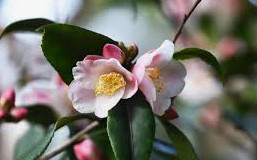Study on drying technology of pistil Camellia

Abstract: In order to study the drying technology of Lianli tea flower, its fresh flowers were treated by microwave drying, thermodynamic drying, microwave drying equipment and thermodynamic drying. After experimental treatment, the best drying technology of Lianli tea flower was as follows: picking cleaning 800 W microwave killing 80 s 60 thermodynamic drying 120 min. _Sample preservation. The dried flower of Lianli tea has good appearance and fragrance, and has a great market prospect, which adds a new variety of scented tea to the market of our country.
Key words: microwave drying of pistil camellia; cyanidation; drying technology; scented tea
Lianli Camellia is a perennial evergreen shrub of Camellia family. It has the potential to develop into natural camellia because of its large amount of flowers, beautiful and fragrant flowers, containing tea polyphenols and other nutrients. At present, there are more than 30 species in the field in China, widely distributed in Yunnan, Guizhou, Sichuan, South China and East China. There are also sporadic distribution along the southern coast and introduction in North China.
Its florescence is concentrated from November to April of next year. The flower color is mainly white or with red spots. Flowers are concentrated and fragrant. Lianli tea has strong vitality and can adapt to a wide range of temperature and moisture changes.
At present, the focus of domestic research on Lianli Tea is only on the investigation of its genetic characteristics or ecological distribution. In recent years, although molecular biology has studied its genetic characteristics, it is still at the preliminary stage of understanding, and there is no systematic research report. Because there are no germplasm resources of Lianli Tea abroad, there is no correlation. Reports.
The author refers to the drying technology of tea to dry the flowers of Lianli Tea in order to obtain the drying technology of Lianli Tea. The research results have certain guiding significance for the development and utilization of Lianli Tea, a unique germplasm resource in China, and also for the better production of the whole Camelliaceae plant. Product development lays the foundation.
Samples of the whole flower of the dew-petaled and half-opened Lianli tea should be collected about 1 kg for each flower. After collection, they should be put into fresh-keeping bags and opened properly to prevent anaerobic breathing. Attention should be paid to preventing crushing and collision during transportation to avoid the browning of damaged petals. Samples can be spread on the table with absorbent paper before treatment. One night.
According to the blooming condition of flowers, the samples were classified into three groups: closed, half-opened and full-opened. According to the shape and shape of flowers, the samples were divided into three groups: A, B and C.
The dew petals of group A were pen-shaped and contained fine-tipped pistil tea, Small-tailed pistil tea and small-egg-leaf pistil tea. The dew petals of group B were long, including Yuelu pistil tea, yellow poplar pistil tea, Xiaochangjian pistil tea, batch pistil tea, pistil pistil pistil pistil tea and pistil pistil pistil tea. The buds of group C were larger than those of group A and group B, and the dew petals closed as follows: Pen-shaped, containing fine calyx pistil tea, wool flower pistil tea, large flower tip pistil tea, bell calyx pistil tea, pistil pistil tea and large calyx pistil tea.